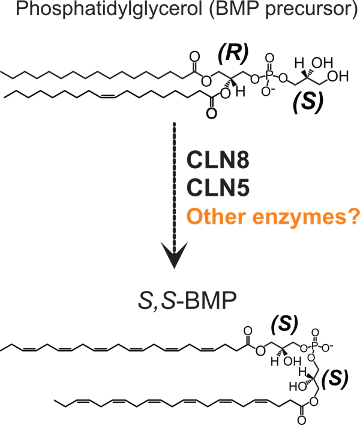Figure: Phosphatidylglycerol, a metabolic precursor of bis(monoacylglycero)phosphate, undergoes multiple enzymatic steps to be converted into lysosomal S,S-BMP. Two of these steps are catalysed by the CLN8 and CLN5 proteins, while the enzymes responsible for the remaining steps have yet to be identified.
Bis(monoacylglycero)phosphate (BMP) is a phospholipid found exclusively in lysosomes and is highly enriched in intralysosomal vesicles. While BMP is known to have a critical role in lipid and membrane protein degradation within lysosomes, both its cellular synthesis pathway and precise molecular function within lysosomes remain poorly understood. This knowledge gap is further complicated by the atypical S,S stereoconfiguration of BMP lipids.
Our laboratory recently identified CLN8 as an enzyme that catalyses a key acyl transfer reaction in the BMP synthesis pathway. The CLN8-encoding gene is one of several CLN genes that cause Batten disease when mutated. Notably, a separate study (Medoh et al, Science 2023) has shown that CLN5, another Batten disease gene product, catalyses a subsequent step in the BMP synthesis pathway. Our ongoing research seeks to define the BMP synthesis pathway in greater detail, investigate its role in Batten disease pathogenesis, and explore whether BMP lipids or their synthesis intermediates could serve as potential therapeutic candidates for Batten disease.
Related publication
Sheokand PK, James AM, Jenkins B, K Lysyganicz P, Lacabanne D, King MS, Kunji ERS, Siniossoglou S, Koulman A, Murphy MP & Petkevicius K# (2025)
TRAM-LAG1-CLN8 family proteins are acyltransferases regulating phospholipid composition
Sci Adv 11(8):eadr3723. doi: 10.1126/sciadv.adr3723
#corresponding author


